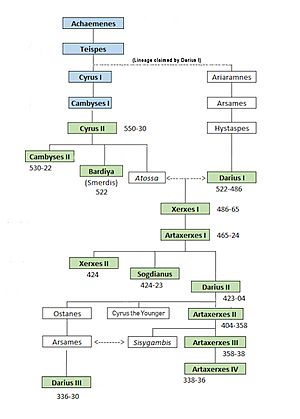Achaemenes facts for kids
Quick facts for kids Achaemenes |
|
|---|---|
| Apical ancestor of the Achaemenid dynasty | |

Position of Achaemenes in the Achaemenid lineage.
|
|
| Successor | Teispes |
| Issue | Teispes |
| Old Persian | Hakhāmaneš |
| House | Achaemenid |
Achaemenes (Old Persian: 𐏃𐎧𐎠𐎶𐎴𐎡𐏁, romanized: Haxāmaniš) was a very important person in ancient Persian history. He is known as the first ancestor of the Achaemenid dynasty. This was a powerful family that ruled a huge empire called the Achaemenid Empire (also known as the Persian Empire). This empire was one of the biggest in the ancient world!
We don't know much about Achaemenes's life or what he did. It's possible he was a legendary figure, like a hero in a story. If he was a real person, he would have lived a long time ago, around the late 700s BC or early 600s BC.
Contents
What Does the Name Achaemenes Mean?
The name "Achaemenes" comes from an old Persian word, Haxāmaniš. This word was also written in other ancient languages like Elamite and Akkadian. You can find it on a famous stone carving called the Behistun Inscription.
The name Haxāmaniš is thought to mean "having a friend's mind." Another idea is that it means "someone who follows with spirit." In modern Persian, the name is spelled Haxâmaneš.
Was Achaemenes a Real Person?
Historians are not sure if Achaemenes was a real person or a mythical ancestor.
Achaemenes in Ancient Inscriptions
The Behistun Inscription was made around 490 BC by Darius I, a later Persian king. In this inscription, Darius says that Achaemenes was the father of Teispes. Teispes was an ancestor of both Cyrus II (Cyrus the Great) and Darius I.
However, Cyrus II himself does not mention Achaemenes in his own family history, which is found on the Cyrus Cylinder. Some people think Darius I might have created Achaemenes as a shared ancestor. This would have helped Darius connect his family to Cyrus the Great's family and make his rule seem more legitimate.
Some scholars believe Achaemenes was a real ruler of a place called Parsumash. They think he might have led armies against the Assyrian king Sennacherib in 681 BC.
Achaemenes in Greek Stories
Ancient Greek writers also told stories about Achaemenes. For example, one story from the late 300s BC says Achaemenes was the hero who founded the Persian people. This is similar to how the Greeks believed they came from the hero Heracles.
Some Greek legends even said that Achaemenes and Heracles were both sons of Perseus, who was a son of Zeus. Another story said Achaemenes was the son of Aegeus, another legendary founder. One writer even claimed Achaemenes was raised by an eagle! These stories show how important Achaemenes was in the legends of the ancient world.
See also
 In Spanish: Aquémenes para niños
In Spanish: Aquémenes para niños

